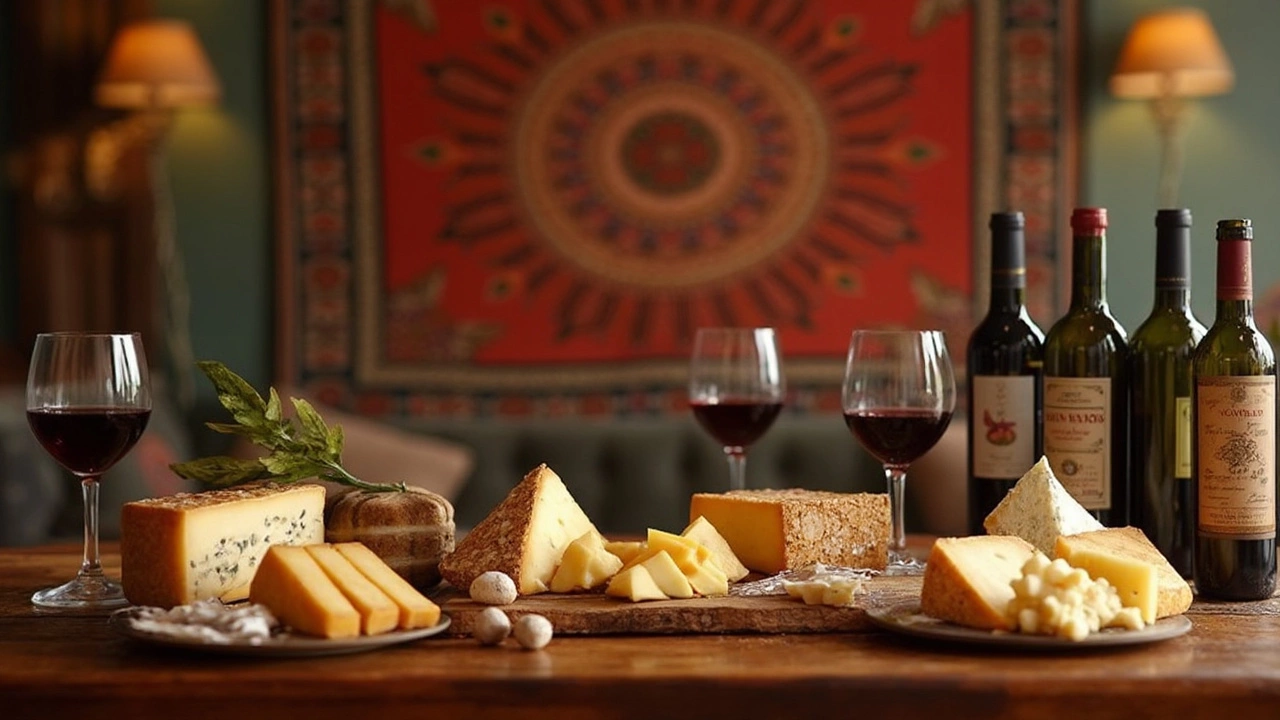
Alright, when you're sitting down with a lovely bottle of wine and a platter of cheeses, ever find yourself wondering, "Do I sip or nibble first?" Sounds like a small thing, right? But this little decision can actually make a big difference in how much you enjoy your tasting experience.
Let's break it down: some folks swear by tasting the cheese first to coat your palate with all that creamy, buttery goodness before taking a sip of wine. Others reckon the opposite, suggesting the wine should come first to set the stage for the cheese's flavors. So, which one is actually the right way to go?
Turns out, it’s not a one-size-fits-all situation—surprise, surprise! Factors like the type of cheese, the wine you're sipping, and even personal preference play a huge role. So how do you figure out what’ll work best for you? Let’s dig into some tips straight from the experts and maybe even have a bit of fun experimenting along the way.
- The Basics of Wine and Cheese Pairing
- Why Order Matters
- Tips from Sommeliers and Cheesemongers
- Creating Your Perfect Pairing Experience
The Basics of Wine and Cheese Pairing
Getting into the nitty-gritty of cheese pairing doesn't have to make your head spin. Think of it like a little chemistry experiment for your taste buds, finding the perfect match that elevates both the wine and cheese. Here are some handy basics to get you started on the right foot.
First thing’s first, let’s talk about flavor intensity. Generally, lighter cheeses go well with lighter wines, while stronger cheeses need a stronger wine to hold their own. Imagine sipping a delicate Chardonnay with a sharp blue cheese—it just wouldn’t work out too well. You'd be left with an overpowering cheese experience and wondering where the wine went.
Now, saltiness is a key player. Saltier cheeses, like feta or Roquefort, often find a nice counterbalance with sweet wines, such as a Sauternes or a Port. The sweetness calms the salt, transforming a potential clash into a harmonious blend.
- Acidity matters: High-acid cheeses, think goat cheese, play nicely with a high-acid wine like Sauvignon Blanc. They both perk up your taste buds without overshadowing each other.
- Tannins and fats: Full-bodied red wines with high tannins love creamy, fatty cheeses. The fat in the cheese tones down those tannins, creating a smoother experience.
- Age considerations: Older wines often pair best with hard, aged cheeses. These cheeses, like a nice aged cheddar, have complex flavors that match the evolved taste of an aged wine.
It's worth noting that regional pairings can be a shortcut. Cheese and wine from the same area have often evolved together, aiming for a natural pairing. They grow up side by side, figuring each other out over centuries.
Remember, there aren't any hard and fast “rules” in the world of wine and cheese pairing. Treat these as guidelines, and don't be afraid to trust your taste buds as you become more confident. Pair something you love eating with something you love drinking, and you’re halfway there to your perfect pairing.
Why Order Matters
Ever thought about why the order of tasting wine and cheese pairing can be such a big deal? It's not just some fancy etiquette; there’s some real science and taste magic behind it. Both wine and cheese have such strong and unique flavors, and how you experience them depends a lot on what hits your taste buds first.
Imagine this: if you start with a rich, strong blue cheese, it might overshadow the more delicate flavors of a white wine. On the flip side, a bold red might overpower a mild cheese if you sip it first. The balance is key to elevating both the cheese and wine flavors, so getting it right can turn good into amazing.
Order can affect how each element of the pairing interacts in your mouth. Starting with a cheese that's creamy or high in fat can coat your palate, meaning the wine that follows can taste softer and fuller. Conversely, a sip of acidic wine before tasting the cheese can cleanse your palate and make the cheese's creaminess pop even more.
So how do you decide which to try first? It can depend on what you’re having. Here's a quick guide:
- With creamy cheeses like Brie or Camembert, try the cheese first to coat your mouth, then sip a crisp white wine.
- For stronger cheeses like Roquefort, you might want to sip a dessert wine first to balance the intense flavors.
- Hard cheeses, such as Cheddar, often go well if you sample the wine first, especially if it's a more robust red.
Feeling fancy yet? Remember, these aren’t hard rules but more like guidelines to enhance your taste trip. Next time you have wine and cheese over, mix it up a bit and see what works for your palate. You might just discover your perfect combo!

Tips from Sommeliers and Cheesemongers
If you're looking to level up your wine and cheese game, listening to the pros can be a game-changer. Sommeliers and cheesemongers know their stuff when it comes to making the most out of each bite and sip.
One popular trick is to start with a sip of wine. This isn't just about flavor; it sets your palate for the cheese by cleansing any lingering tastes. So, when you nibble that cheese, you’re really tasting its true essence rather than fighting earlier flavors.
On the flip side, if you're dealing with particularly creamy or bold cheeses, try a bite first. Cheesemongers say this helps the cheese coat your mouth, prepping it to better absorb and enhance the wine’s flavors. It's especially noticeable with strong blue cheeses paired with bold reds.
Here are a few more handy tips straight from the experts:
- Match intensity: Pair bold cheeses with robust wines like a Shiraz or Cabernet, and lighter cheeses with something more delicate like a Pinot Grigio.
- Sweet and salty: Try pairing a sweet wine like Sauternes with salty cheeses like Roquefort for a balanced contrast. This blend often pops up on lists of classic pairings!
- Regional pairings: Sticking to the same region for both your cheese and wine is a pretty safe bet. Like a French Brie with a Chardonnay from Burgundy.
The idea isn’t to find some ultimate truth but to discover what tickles your own taste buds. Plus, who doesn’t love a good opportunity to keep trying different cheese pairings?
Creating Your Perfect Pairing Experience
Alright, let’s get down to crafting that perfect wine and cheese pairing experience. Think of it as a mini adventure for your taste buds! Whether you’re a newbie or a pairing pro, a few simple steps can take your tasting from okay to 'wow!'
First up, start by selecting cheeses and wines that complement each other. A good rule of thumb is to match intensity. Pair mild cheeses like Brie with gentle wines such as a Chardonnay. If you’re diving into a bold blue cheese, grab a Port or a bold Cabernet Sauvignon.
Temperature matters! Let your cheese sit at room temperature for about an hour before serving. This lets the flavors open up fully. For wine, follow the general guideline: whites should be chilled, and reds closer to room temperature. But hey, if you have a preference, go with what you love.
- Try a flight: Experiment with three different cheeses and wines to compare and contrast. Perhaps a soft, a hard, and a blue cheese?
- Consider regional pairings: French wine with French cheese, Italian wine with Italian cheese; native pairings often work like a charm.
- Add accompaniments: Little extras like honey, nuts, or fruit can highlight different flavors and bring harmony to your pairing.
Remember, there's no one-size-fits-all formula. Sometimes it’s just about experimenting and seeing what tickles your taste. Have fun with it and maybe even invite friends over for a tasting party!
Check out this simple statistics table below that sums up some popular pairings enjoyed by enthusiasts around the globe:
| Cheese | Wine | Popularity (%) |
|---|---|---|
| Brie | Chardonnay | 60% |
| Cheddar | Merlot | 75% |
| Gorgonzola | Port | 50% |
Now you’re ready to create your unique pairing experience. Trust your palate, and most importantly, enjoy the journey!





Categories